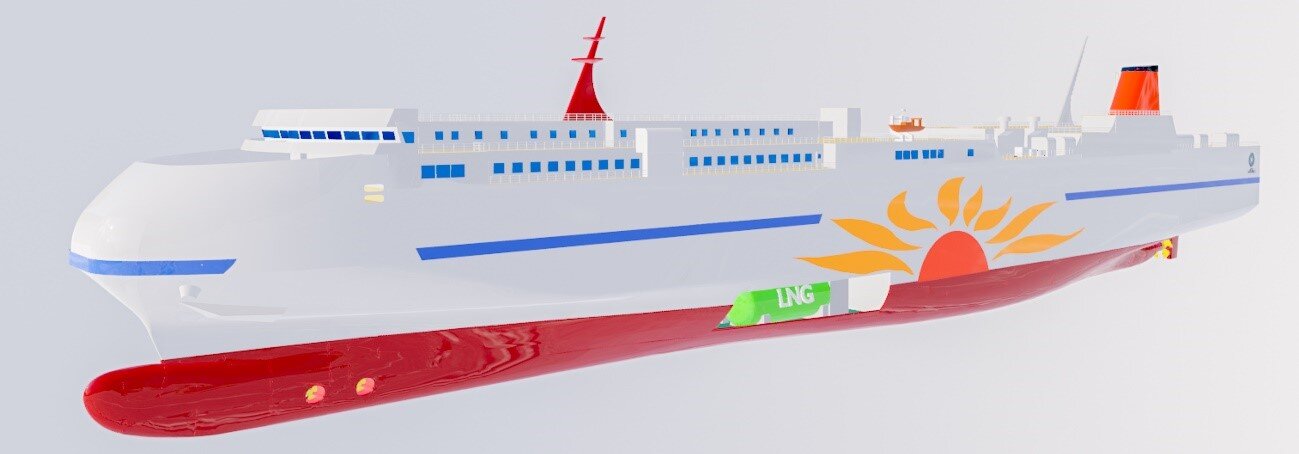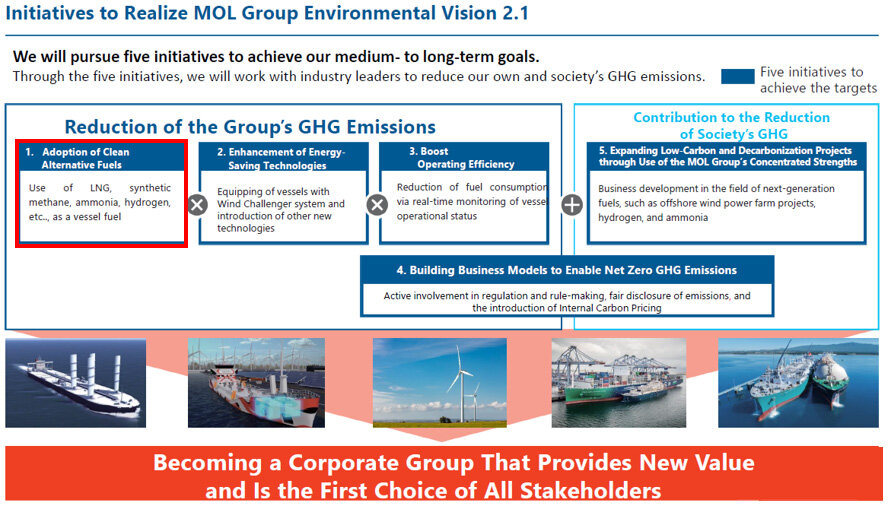- JP
- EN
MOL and MOL Ferry to Build 2 Cutting-edge LNG-powered Ferries
- Introducing Super Eco Ferries Adopting Wind Power: Responding to Accelerating Modal Shift -
February 17, 2022
Mitsui O.S.K. Lines, Ltd.
MOL Ferry Co., Ltd.
Naikai Zosen Corporation
TOKYO-Mitsui O.S.K. Lines, Ltd. (MOL; President & CEO: Takeshi Hashimoto; Headquarters: Minato-ku, Tokyo) and its group company MOL Ferry Co., Ltd. (President: Naotoshi Omoto; Headquarters: Chiyoda-ku, Tokyo) today announced orders for construction of two cutting-edge LNG-fueled ferries.
MOL signed a deal with Naikai Zosen Corporation (President: Kosaku Hara; Headquarters: Onomichi-shi, Hiroshima Prefecture) to build the two ferries. The vessels are slated for delivery in 2025, and will replace two vessels (Note 1) that MOL Ferry currently operates on the Oarai-Tomakomai route.
The MOL Group is currently building Japan's first two LNG-fueled ferries, "Sunflower Kurenai" and "Sunflower Murasaki" (Note 2), entering service in 2023, and with the addition of these two new vessels to be ordered this time, the MOL Group will lead the industry in terms of environmental responsibility.
The new ferries will reduce CO2 emissions by about 35% in comparison with ferries currently in service, by adopting the latest technologies. The MOL Group will reduce environmental impact by introducing the next-generation super eco ferries.

3 Main Characteristics
- Use of LNG fuel
Compared to conventional marine fuel oil, LNG is expected to reduce emissions of carbon dioxide (CO2) by about 25% and sulfur oxide (SOx) by virtually 100%, allowing for a significant reduction of vessels' environmental impact. - Adoption of the latest technologies
The new ferries adopt the "ISHIN" ship design,(Note 3) which features a streamlined shape with an aerodynamically rounded the bow and can use diagonal headwinds to help propel the vessel. These ferries will be also equipped with high-performance, high-efficiency engines. In addition, new technologies such as energy-saving device developed by Naikai Zosen have been incorporated to further reduce CO2 emissions. - Response to Modal Shift(Note 4)
As the number of trucks is expected to increase due to the acceleration of Modal Shift, all cabins will be private, offering additional comfort not only for passengers but also long-distance truck drivers. MOL group will contribute to reducing CO2 emissions by supporting Modal Shift.
The MOL Group set the target, "With the concerted effort throughout the Group, achieve net zero GHG emissions by 2050" in "MOL Group Environmental Vision 2.1" (Note 5). It is promoting the wider adoption of LNG fuel through development and advancement of an LNG fuel supply system in Japan and overseas. It also plans to launch about 90 LNG-fueled vessels by 2030 as an initiative to introduce clean alternative fuels (Fig.1). The group will develop technology for LNG-fueled vessels and safe operation through development, construction, and operation of the new ferries, and take an active stance in fostering the use of LNG fuel. The MOL Group is united in working to meet the needs of customers and society at large for a cleaner environment and the realization of a low- and decarbonized society.
Naikai Zosen launched development of an energy-saving device called the "Spray Tearing Plate," (Note 6) which will be installed on the new ferries to further boost energy efficiency to improve energy-saving technology. With this order for new LNG-fueled ferries, which are the first LNG-powered ferries for Naikai Zosen, the company aims to win additional orders for eco-friendly LNG-fueled coastal ferries and RoRo ships and will contribute to ocean transport as a shipyard that can build vessels to deliver advanced environmental performance.
(Fig. 1)

(Note 1)
Please refer to the chart below for a comparison between ferries Sunflower Daisetsu and Sunflower Shiretoko currently in service and the new ferries.
| Newbuilding ferries (plan) | Current ferries in service | |
|---|---|---|
| Ship name | TBD | Sunflower Daisetsu Sunflower Shiretoko |
| Passenger capacity | 157 | 154 |
| Vehicles (units) | 50 | 62 |
| Truck loading capacity (units) (converted to 13m) |
155 | 135 |
| LOA | 199.4m | 190.0m |
| Gross tonnage | About 15,600 tons | About 11,400 tons |
| Main engine | One low-speed engine | Two medium-speed engines |
| Mail fuel | LNG (the vessel can also be operated on compliant fuel oil) | Compliant fuel oil (C heavy oil) |
(Note 2)
Please refer to the past news releases related to the Sunflower Kurenai and the Sunflower Murasaki.
- November 20, 2019 press release:
MOL Group to Build Japan's 1st LNG-fueled Ferries: Sunflower Kurenai an Sunflower Murasaki
- July 15, 2020 press release:
LNG-fueled Ishin, Sunflower Kurenai and Sunflower Murasaki Earn Top Energy Conservation Rating for Japanese Coastal Ships
(Note 3)
The ship design features a shape that reduces wind pressure from the bow and the sides-jointly developed by MOL, MOL Techno-Trade, Ltd., Akishima Laboratories (Mitsui Zosen) Inc. It smooths out the wind flow and uses lift force received from diagonal headwinds to help propel the ship. This utilizes the characteristics of ferries operating at high speed.
(Note 4)
The Modal Shift is an initiative to switch to ocean cargo transport with coastal vessels and railway transport as alternatives to long-distance trucking. Today, it is drawing attention as a solution to a shortage of long-distance truck drivers and the need to reduce CO2 emissions. In addition, ferries have earned favorable comments from truck drivers and shipping companies because drivers can rest and relax while their trucks are onboard. MOL Group ferries and coastal RoRo ships offer reliable, frequent sailings, avoiding delays caused by traffic jams and accidents that plague overland trucking.
(Note 5)
MOL Group Environmental Vision 2.1
https://mol.disclosure.site/en/themes/101
(Note 6)
The Spray Tearing Plate (STEP) is a rectangular energy-saving device that suppresses resistance from waves and swells on the surface of the water.
Naikai Zosen and the National Institute of Maritime, National maritime Research Institute of Port and Aviation with Technology jointly acquired a patent for the STEP. The effects can be demonstrated by attaching a STEP on both the left and right sides of the upper part of the bow. Normally, when a vessel is underway, waves facing the bow create resistance, reduce speed, and detract from fuel efficiency. But installation of the STEP prevents this resistance by separating the waves on the bow from the hull, resulting in higher fuel efficiency. Tests have shown that the fuel efficiency of the vessels equipped with STEP improved by about 2% under actual operating conditions. It has earned high evaluations from various perspectives, such as reducing vessel operating costs and reducing environmental impact.

